Blueberries in Pots Project
| |
|
|
Introduction |
|
|
Colorado's high pH soils prevent us from producing blueberries in the ground but not in pots! Blueberries prefer to grow in low pH soils, so we have been experimenting with different soil mixes and fertilizers to create an acidic environment for the blueberries to grow in. We have also been moving potted plants into the greenhouse during the winter forcing early berry production. Blueberries are a rare crop in Colorado and winter greenhouse forcing could allow growers to tap into a high priced winter market as well. |
|
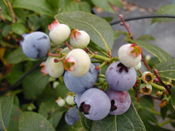 |
| |
|
|
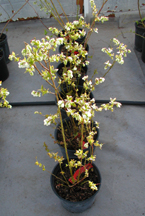 |
|
In 2003, we planted three varieties of blueberries (Polaris, North Sky, and North Country) in four different soil mixtures. The four media types used were a coir mix, peat mix, coir/peat mix, and ground pine bark mix. Winter survivability and the performance of these varieties in the different soil types are being evaluated. This experiment was also repeated at a home patio location with our collaborator Dr. Cecil Stushnoff.
In 2004 we acquired additional blueberry plants of the varieties Burgundy, Bluegold, Chippewa, Bluetta, Northland, Rubel, and Northblue in addition to Polaris. These varieties are being evaluated for potential winter greenhouse forcing. Half of the plants (10 of each variety) are brought into the greenhouse in January and half of the plants are left outdoors. |
Blueberry plant blooming in February 2005
|
|
|
|
Methods and Preliminary Results
Soil Mix Experiment
The bare-root blueberry plants acquired in 2003 were planted into four different soil mixes as displayed below. Four plants of each of the three varieties (Polaris, North Sky, and North Country) were planted into each of the four types of soil mixes in 2-gallon pots. The ideal soil pH for blueberries is 4.5 to 4.8 but they can still grow well in soil with a pH of up to 5.2.
| Name of mix |
Components (by volume) |
pH range* |
| peat mix |
80% peat, 20% perlite |
3.5 to 4.6 |
| coir/peat mix |
40% coir, 40% peat, 20% perlite |
4.2 to 5.0 |
| coir mix |
80% coir, 10% peat, 10% perlite |
4.6 to 5.6 |
| bark mix |
80% ground pine bark, 10% peat, 10% perlite |
4.8 to 5.7 |
*based on 3 months of pH testing from planting in April through June 2003.
The peat mix gave the lowest pH but was almost too low. The coir (shredded coconut husk) and peat mix gave the best pH range for blueberries. The bark mix also gave an adequate range but also dries out more quickly than the other mixes and requires more frequent watering.
Two other soil mixes were tried initially- a composted bark mix and a cottonseed mix. These mixes were not successful because the pH values were way too high. The cottonseed range was from 8.1 to 8.3 and the composted bark mix's range was from 7.0 to 7.4. We suspect that a buffering agent like gypsum may have been added to the composted bark mix since it would normally have a much lower pH. It is strongly recommended that growers test the pH of the soil medium they choose several times after leaching it to make sure it is an appropriate media.
Another way we tried to keep the pH low was by using ammonium sulfate or a high acid soluble 21-7-7 fertilizer. We also fertilized these blueberries with a slow releasing 14-14-14 fertilizer. We are currently experimenting with using vinegar in our irrigation water to keep the pH low, possibly making it a good method for organic growers.
The blueberry plants for the soil mix experiment were planted in a pot-in-pot system in which a hole was dug in the ground and a large pot placed in the hole, then the actual pot with the blueberries was put in this pot. The pot-in-pot method helps moderate pot temperatures, prevents the plants from dying out too much, and keeps pots from blowing over. It also isolates the plant roots from the high pH soils of this region. An automated drip irrigation system was used to irrigate these plants.
Blossoms were removed from the plants during the spring of 2003 so that the plants would put their energy into establishing their root systems. During the winter of 2003-2004, the plants were covered with a floating row cover to help prevent desiccation. The fierce Colorado winds often blew the row cover off and unfortunately, many of the branches suffered from winter kill. Therefore there was little to no blueberry production during the summer of 2004.
This experiment was also repeated at a home patio location. The plants at this location were covered with burlap during the winter to exclude sunlight and increase humidity around the plant. The covered plants had little winter damage and produced a very good bloom. The uncovered plants clearly had much more desiccation injury with twig die back. Blueberry plants may not have much tolerance for the low humidity of Colorado. A high elevation setting with low humidity and no snow cover is tough on the plants. Early season freezing events are also detrimental to berry production. Northblue appears to be the best adapted cultivar to this climate situation for home patio production based in preliminary observations.
Back to Top of Page
Greenhouse Forcing Experiment
The bare-root blueberry plants acquired in April of 2004 were planted in 2-gallon pots into a local source of composted pine bark (80% by volume), with perlite (10%), and peat (10%) and fertilized with 1 Tbsp. of a slow release 14-14-14 fertilizer. Blossoms were removed and the potted plants were kept outside (and also covered with floating row cover in the winter) until January 15, 2005 when ten of the twenty plants per variety were brought into the greenhouse. Immediately the buds began opening. In mid-February, they were again fertilized with a slow-release 14-14-14 fertilizer and a beehive was brought into the greenhouse to facilitate pollination. The plants were also fertilized weekly with a high acid soluble 21-7-7 fertilizer.
The remaining 10 plants of each variety were left outside for outdoor late spring and summer production. Unfortunately a snowstorm on April 29th killed many of the flowers and so few plants produced berries in 2005.
The yields below are from the spring of 2005 for the greenhouse plants. Please note that these are first year yields and that the yields are totals for 10 plants.

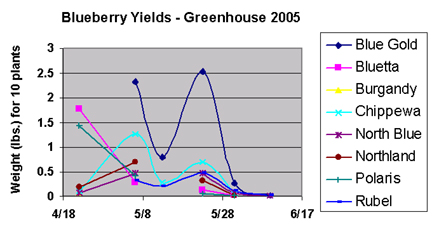
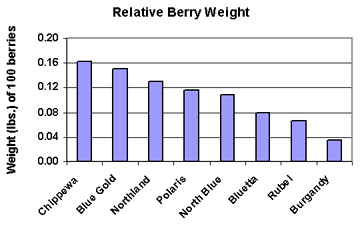
Bluegold was clearly the winner for yield over a 2-week harvest window. The Polaris plants were the healthiest looking and had dense clusters of fat berries. Bluegold had very tight berry clusters with berries that held on well. We did have some aphid problems on Bluetta, North Blue, and Burgundy. Burgundy produced the fewest flowers and approximately 80% of them failed to develop into fruit. The reason for this is unknown.
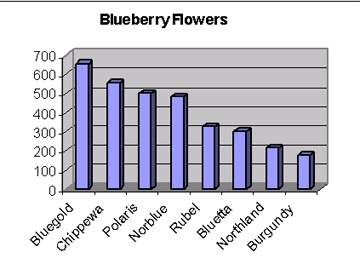
In addition to yield data, Dr. Cecil Stushnoff evaluated the concentrations of antioxidants using total phenolics (mg gallic acid equivalents per 100 grams fresh weight, assuming 20%
dry matter, which may differ for varieties).
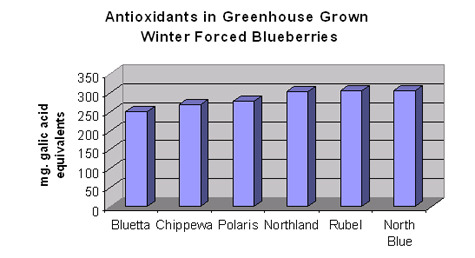
These values are similar or slightly lower than those reported elsewhere. It is surmised that the lower concentrations of phenolics are a response to the greenhouse environment.
Future Research
We are continuing to monitor the pH of the different soil mixes and are experimenting with using vinegar for keeping the soil pH lower for organic growers. We have also brought half of the blueberry pots into the greenhouse again this winter of 2006 to get a second year of harvest data. We will post that data on this website when it becomes available.
Back to Top of Page
|
| |
|
|
The varieties chosen are mostly half-high blueberries which were bred to be hardy (like the lowbush varieties) and to have a large, sweet berry (like the highbush varieties). The source for much of the variety information comes from: www.hort.cornell.edu and www.weeksberry.com and describes plant growth for in-ground plants, not in pots. Growth habits of our potted plants will be posted as we learn more from this experiment. |
|
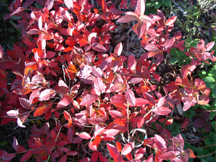 |
Bluegold: Midseason. Cold hardy Bluegold features a compact, round bush up to 4 feet that is perfect for landscaping. Fall foliage and winter wood are a golden yellow, followed by bright-white blooms in the spring. The firm, flavorful berries form large clusters that are easy to pick. Because of the heavy fruiting habit, commercial growers sometimes refer to it as the "mortgage lifter," the plant breeders just called it Bluegold.
Bluetta: Produces early fruit with a good yield of medium-sized fruit with fair quality. It is a vigorous, upright plant. It is very hardy but has small dark berries that are difficult to machine harvest.
Burgundy: A very small plant, wild type. The berries are very small but tasty and high in antioxidants.
Chippewa: Has produced 3-8 pounds of fruit per bush in New York and grows to a height of 30-40 inches. It is a very winter hardy cultivar that is productive with large firm fruit. This half-high bush is relatively new and has not been widely tested.
NorthBlue: The height of the bush is from 30-40 inches. Northblue was introduced from the University of Minnesota in 1973. It produces plump, sweet and firm navy blue fruit. Very good quality fruit with a wild blueberry flavor that is superior to most highbush varieties. With refrigeration, the berries will store well. Large, dark green leaves will turn red in the fall. It can yield 3 to 9 pounds per bush if snow cover is adequate for winter protection (yield data from Oregon). It ripens in mid-July and is hardy to -35 degrees F.
NorthCountry: Medium size sky blue fruit with little or no picking scar. The berries have a mild and sweet wild blueberry flavor. Good quality. Tough and vigorous plants will grow 18 to 24 inches tall and 30 to 40 inches wide. They have yielded 2 to 7 pounds of fruit per plant in Oregon. Production is best when snow protection is adequate. They ripen about 5 days before Northblue. Recommended for commercial use. Hardy to -35 degrees F
Northland: As the name suggests, Northland is very winter hardy. It is a half-high bush with small, dark, soft fruit. It is productive but requires heavy pruning. It is an early, midseason cultivar. It is the most cold-hardy half-bush variety grown. It reaches about 4 feet high and 4 feet wide at maturity. It is a very productive variety, often yielding over 20 pounds per bush in New York when mature. The berries are dark blue and medium size, excellent for jams and baking because of their high sugar content. It is easy to grow and adaptable to many soil types. Northland's cold hardiness extends the area where highbush blueberries can be successfully raised. The bright yellow wood and compact shape fits well in the landscape, especially when grouped with other compact varieties like Bluetta, Bluegold or Patriot.
Northsky: Yields from 1-3 pounds a bush (yield data from Oregon) and grows to a height of 12-18 inches. It was developed at the University of Minnesota . It produces small to medium, light blue fruit with dusty blooms, which are smaller than Northblue. They have an excellent wild blueberry flavor that is superior to most highbush varieties. It is a low spreading bush with dense foliage. Small dark green leaves turn red in the fall. It is a good variety for areas with severely cold winters, but abundant snow cover to insulate the plant.
Polaris: Produces 3-8 pounds of fruit per bush (yield data from New York) and can have a height from 30-40 inches. It is hardy with medium large berries with a very firm, crisp texture. The berries have an intense aromatic flavor and store very well. It requires a second cultivar for pollination.
Rubel: Highbush; Late midseason. Rubel is living proof that older is oftentimes better. This "heritage" blueberry was one of the first ever selected, discovered growing wild in the Pinelands of New Jersey and named by D. Frederick Coville in 1912. It has continued to be popular all of these years with commercial growers because of its uniformly small fruit, dark color, and intense flavor. These are the perfect baking berries. Blueberries are attracting attention from all points due to their extremely high antioxidant levels. Now current research has shown that Rubel scores almost twice as high as most other blueberries. Rubel is a strong, upright bush of six feet or more at maturity. It is a consistent producer and easy to pick.
Back to Top of Page
Last updated 2/21/06
|